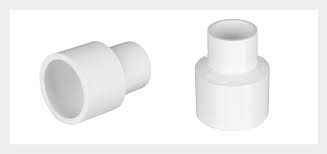Types of electrical conduits and pipes
- PVC pipes
- Rigid PVC Conduit
- EMT Conduits
- RMC Conduits
- IMC conduits
- RGS conduits
- Flexible Metallic Conduits (FMC)
- Liquidtight Flexible Metal Conduits (LFMC)
- Liquidtight Flexible Non metallic Conduits (LFNC)
- Electrical Nonmetallic tubing (ENT)
- PVC stands for (Poly Vinyl Chloride)
- It contains plastic materials so it is highly flexible and easy to adapt
- It is considered the lightest in weight and cheapest type of conduits compared to other types of electrical conduits
- PVC tubes are only used for embedded use in concrete or walls
- The plastic material makes the pipe resistant to any moisture
- It can be bent simply by using special heating tools in field
Rigid PVC Conduit
- It is like a pvc plumbing pipe but thinner than it .
- It can be bent to change direction by using a portable heater box .
- Rigid pvc conduits are installed using plastic fittings that are glued together so that the raceway can be watertight making rigid pvc conduits suitable for outdoor and direct burial in ground applications
- It can be installed embedded in concrete and in outdoor and underground applications .
- It is also ideal for use in dry and corrosive locations .
- It is available in various sizes ,the small sizes are installed in concrete inside ceilings and walls or exposed on ceilings or walls but the large sizes can be installed underground between buildings and structures to allow installation of power and communication cables .
EMT Conduits
- EMT stands for (Electrical Metallic Tubing)
- This type of pipes is commonly made of galvanized steel or steel-coated aluminum
- it is a light weight and thin wall tube and less costly compared with GRC tubes
- It is used for the installation of electrical conductors in both exposed and concealed work
- It is commonly used in commercial and industrial buildings than in residential applications
- It is commonly used for exposed indoor wiring runs in commercial and industrial buildings
- This type of tube can be used in wet locations or in concrete or even direct contact with the earth on condition all tubes and their fittings are coated with corrosion resistant material
- It is a rigid pipe but can be bent by a simple tool called conduit bender in case of need to change its direction
- It is a famous to be used to protect fire alarm system cables in case of exposed installations over false ceilings
- EMT pipe is internally coated with organic insulation which makes it smooth so it can be easy to pull the wires inside .
- EMT is available in many sizes commonly from 1/2 through 4 inch
- EMT must be supported at no more than 10 ft (3.0 m) intervals, and within 3 ft (900 mm) of each "outlet box, junction, device box, cabinet ,conduit body and other tubing terminations) and a strap must be used within 3 ft (900 mm) of each coupling.





























